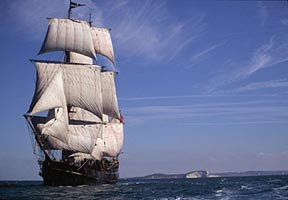 by Kathryn Hadley
by Kathryn HadleyThe English naval commander Sir John Narbrough’s diary was discovered alongside a series of illustrated maps and drawings earlier this year with the family papers of the Earls of Romney at the Centre for Kentish Studies. The hand-written journal, which had been lost for the past 300 years, is now the subject of a desperate battle between a private collector and the British Library in their respective attempts to it for their own collections.
The document is currently owned by a foreign private collector who bought the journal and maps for £310,000. However, English law stipulates that any original manuscript must be granted a special export licence before it can be sent abroad and a temporary export bar has been imposed by culture minister Barbara Follett until November 7th. In the meantime, the British Library is pursuing its efforts to collect the necessary funds to equal the buying price and purchase the diary. The British Library has so far raised £90,000 and has also secured a £200,000 grant from the National Heritage Memorial Fund. It still, however, has a further £30,000 to collect.
Why is Narbrough’s diary such a prized document? Who was the naval commander? While the names Sir Francis Drake, Sir Walter Raleigh and Captain James Cook are well-known, Sir John Narbrough remains relatively unheard of. But maybe the explorer has been unfairly forgotten precisely because his journal was never published and was lost for more than three centuries.
The diary records in great detail Narbrough’s two-year journey to Patagonia and the Caribbean in an attempt to establish trading links with South America and the Pacific. He was the first British sailor to navigate around the Straits of Magellan, opening the way for British trade in the Pacific.
John Narbrough was born in approximately 1640 into a large family in Norfolk. He began his career as a cabin boy serving in merchant ships in the 1650s and early 1660s. In October 1664, he was commissioned as lieutenant of Admiral Sir Christopher Myng's ship Portland. On May 15, 1669, he was commissioned captain of The Sweepstakes and embarked on his voyage to South America. He set sail from Deptford on November 26th, 1669, and entered the Straits of Magellan in October of the following year. Narbrough was thereafter second captain of the Lord High Admiral’s ship the Prince during the Third Anglo-Dutch War (1672-74) and was commended for his conduct during the Battle of Solebay off the Suffolk coast in May 1672. Shortly afterwards he was made Rear Admiral and knighted. He also participated in various expeditions against the Tripoline and Algerine piracies and, in 1680, he was appointed commissioner of the Navy. Narbrough died of a fever in the West Indies in April 1688.
Peter Barber, the head of map collections at the British Library, described the importance of Sir John Narbrough’s voyage to the Straits of Magellan in an article published today on MailOnline:
'His journey proved it was possible for Britain to get involved in the Pacific
trade, which set the direction of our foreign policy for the next 50 years […]
The repercussions are extraordinary - if Sir John hadn't made his trip,
Britain probably would not have gone into the War of the Spanish Succession and
there would never have been the South Sea Bubble of 1720-21 - the biggest
financial crisis of the 18th century.'
For further information on the history of the Falkland Islands, read our article Sovereignty and Heraldry: The Case of the Falklands
For further information on Sir Francis Drake, read 'That Golden Knight': Drake and His Reputation and The Mystery of Francis Drake's Californian Voyage

1 comment:
Nice information
___________________________________
camping
Post a Comment